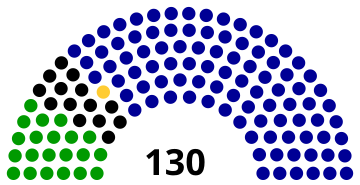1989 Taiwanese legislative election
| |||||||||||||||||||||||||||||||||
All 130 seats in the Legislative Yuan 65 seats needed for a majority | |||||||||||||||||||||||||||||||||
|---|---|---|---|---|---|---|---|---|---|---|---|---|---|---|---|---|---|---|---|---|---|---|---|---|---|---|---|---|---|---|---|---|---|
| |||||||||||||||||||||||||||||||||
Legislative elections were held in Taiwan on 2 December 1989 to elect members of the Legislative Yuan.[1]
Background
[edit]Compared with the sixth supplementary election the number of new delegates to the Legislative Yuan had been increased from 100 to 130. Of these, 101 were to be elected directly representing Taiwan Province and the special municipalities of Taipei City and Kaohsiung City. The remaining 29 seats were to represent overseas nationals, these delegates were appointed by the President.
Results
[edit]Turnout for the supplementary election was 75.5%. Of the 101 directly elected delegates, 72 belonged to the Kuomintang, 21 to Democratic Progressive Party and 8 were independents.
By virtue of achieving more than 20 seats, the Democratic Progressive Party secured the prerogative to propose legislation in the Legislative Yuan.
 | |||||
|---|---|---|---|---|---|
| Party | Votes | % | Seats | +/– | |
| Kuomintang | 94 | +11 | |||
| Democratic Progressive Party | 21 | +9 | |||
| Chinese Youth Party | 1 | –1 | |||
| Independents | 14 | +8 | |||
| Total | 130 | +30 | |||
| Valid votes | 9,115,778 | 96.25 | |||
| Invalid/blank votes | 354,748 | 3.75 | |||
| Total votes | 9,470,526 | 100.00 | |||
| Registered voters/turnout | 12,600,901 | 75.16 | |||
| Source: Nohlen et al.[2] | |||||
References
[edit]- ^ Joseph Bosco (1994) "Faction versus Ideology: Mobilization Strategies in Taiwan's Elections" The China Quarterly, No. 137, pp28–62
- ^ Dieter Nohlen, Florian Grotz & Christof Hartmann (2001) Elections in Asia: A data handbook, Volume II, pp539–554 ISBN 0-19-924959-8



